
By JORDAN ESSOE/YachatsNews.com
WALDPORT – The first Port of Alsea meeting seeking solution for Eckman Lake’s problems with pollution and harmful algal blooms was met with some public opposition Tuesday.
But on Wednesday, the Port suggested a new, potential path forward that might entice frustrated lakeside homeowners – allowing them to take ownership of the lake and manage it themselves. The Port currently owns the majority of the lake just east of Waldport adjacent to the Alsea River.
“Turning [Eckman] back into a tidal estuary is an option. Trying to maintain it as a lake is an option,” Port manager Roxie Cuellar told YachatsNews. “But another option is to let the residents buy out the Port’s interest in the lake and establish a lake improvement district, like what occurred at Devil’s Lake.”
The Devils Lake Water Improvement District in Lincoln City was formed in 1984 and is funded by homeowners to manage and treat Devil’s Lake, which also has ongoing problems with harmful algal blooms.
If homeowners were interested, transferring ownership of the lake would have to be approved by the Port of Alsea board. Cuellar will announce the idea in the Port’s next newsletter, which should arrive in mailboxes sometime in December.
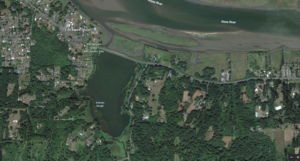
Eckman Lake, a manmade reservoir off the lower Alsea River was created in the late 1950s by the installation of a dam under Oregon Highway 34. It is the center of a small community of homes that use the water for fishing and recreation. The lake is also used by other locals and visitors, and the site of a small state parks recreation area.
The water has become increasingly eutrophic as it has shallowed and warmed over the decades. These low oxygen and nutrient rich conditions encourage a cycle of harmful algal blooms, as documented by the Department of Environmental Quality, which found toxins in the lake in 2018. Once toxins develop in a lake, they are likely to recur.
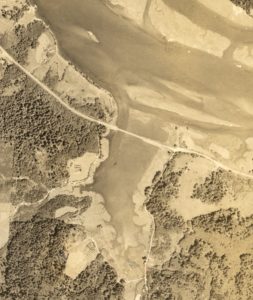
Harmful algal blooms are difficult to track because agency resources for testing are often limited and blooms may develop and resolve too quickly to capture accurate samples. Blooms vary from mild to severe, and not all produce toxins. Mild exposure can give someone a skin rash or an upset stomach. Extreme exposure to toxins can result in severe illness or death for wildlife, pets, or people.
DEQ has not tested the lake since 2018, but the telltale signs of blooms have been consistently observed over the last decade by residents and members from the Oregon Department of Fish and Wildlife, the MidCoast Watershed Council, Oregon Parks and Recreation Department, and others.
“The conditions of the lake seem to have gotten worse over the years,” said mid-coast parks manager Dylan Anderson, whose crew put up posters by the W. B. Nelson State Recreation Site dock to warn the public about harmful blooms.
Difficult solutions
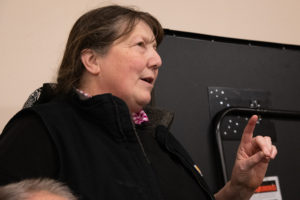
Solutions to resolve problems with the algae are limited in variety, expensive, and contentious – as was on display Tuesday night.
Portions of Eckman Lake not owned by the Port are the property of individual lakeside homeowners. Some present at Tuesday’s meeting voiced objection to any proposal that would restore the now-shallow lakebed to its natural state as a tidal channel.
“Everyone’s saying it should be a lake, but the science may say it should be an estuary,” said Port board chair Robin Bishop, discussing the tidal channel solution identified by some as the only reliable way to reverse eutrophication, eliminate toxic algae, and create environmental stability.
Homeowner concerns Tuesday night over ideas that might dramatically alter the lake’s current form ranged from sentimental to ecological to financial.
In a written letter read aloud, homeowner Jim Robinson said: “Landowners have purchased property around the lake because it is a lake. We all paid a premium for lakefront property. It’s a part of our resale value.”
The Port’s goal is to make room for all stakeholder voices while still protecting public safety and identifying an affordable strategy. When dredging the lake was suggested, board vice-chair Buster Pankey suggested it could cost as much as $5 million. Former Port of Alsea board chair Mark Wiederhold said “if we just dredge it out, [the problem] will come back.” Treasurer Jan Power agreed dredging is not a viable option.
The Port may have the authority to pursue a solution without homeowner cooperation, but Cuellar said they feel it would be undesirable to pursue a fix for the lake without cultivating consensus throughout the community.
And reaching a consensus will be challenging. Emotions about the lake run deep.
“Eckman is more than a lake. It is our home,” said Ashley Catalfamo, who was born, grew up, and raised her family by the lake. “It is our little slice of heaven, and now it is under attack.”
Catalfamo and others Tuesday night insisted on a need for more information and more testing, feeling that the 2018 toxin levels were recorded too long ago and found in too small a concentration to build a confident case. Catalfamo attacked even the use of the term “toxic algae.”
If no one currently knows of a case where someone fell ill from toxic algae at Eckman Lake, does that mean the water is toxin-free and safe?
“Toxic algae was found in the lake,” said MidCoast Watershed Council coordinator Evan Hayduk. “We don’t want to wait until someone gets sick to do something.”
Everyone seemed to agree on the need for more water testing.
Jamie Michel, a key landowner of the eastern shoreline, asked how soon new testing could be expected, but Cuellar cautioned that it shouldn’t be done tomorrow or even before the next meeting. She said water tests need to be done during the summer or early fall when algal blooms are active. Otherwise the test results will likely be irrelevant.
Specialists who have a professional understanding of algae, toxins, and testing did not attend the meeting, so when those concerns were raised, there was no one to effectively answer them.
“Of all the agencies, the one that really needs to be here is the Department of Environmental Quality,” said John Spangler, ODFW’s district biologist. “They do the water quality testing. They are the experts, and they need to be at the next meeting.”
Cuellar said they were supposed to have been there. Guests were encouraged to fill out questions for the DEQ on index cards.
On Wednesday a DEQ representative told YachatsNews that, if invited by the Port or MidCoast Watershed Council, they may attend the January meeting. City managers and county commissioners have also been encouraged to participate, as well as a representative from the Oregon Health Authority.
Port promises better notice
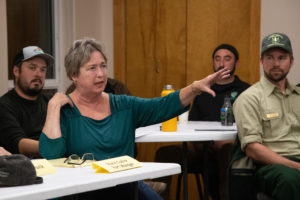
“By the time we get to [the third meeting] in February, we should have many more answers than we have now,” Port of Alsea manager Roxie Cuellar said Tuesday night, reiterating a point made by board members that the port is only at the beginning of its fact-finding on Eckman Lake water quality issues.
Despite there being over 35 people in attendance Tuesday, the Port’s reliance on Facebook community page postings, flyers at Lakeside Market, and word-of-mouth promotion were considered by some to be insufficient and disrespectful to homeowners. There were no individual phone calls, emails, or letters sent. YachatsNews published an extensive story on the issue six days prior to the meeting.
Cuellar was defensive about this Tuesday night, but told YachatsNews on Wednesday that she understands the need for a more hands-on approach. She said she will make sure each lakeside homeowner receives a physical notification in the mail for the second outreach meeting, which will be held at the Waldport Community Center on a day in January to be determined.
Hayduk plans to post more flyers and attend a community meeting where homeowners gather.
Catalfamo and others balked at the decision to hold the February meeting in Yachats, a community miles away from the lake and its immediate community. Board members explained that Yachats is an important part of the Port’s district, and that all property taxpayers across the district need to be inluded in the discussion.
A fourth meeting may be added to the schedule and again held near the lake.
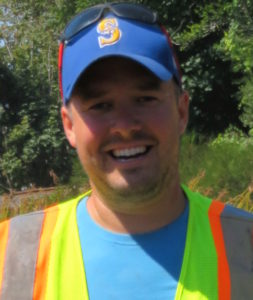
Hayduk told YachatsNews he now thinks – after the strain present in Tuesday’s public dialogue – that a realistic result of this first set of meetings may be limited to starting a two- or three-year plan to monitor lake temperature and nutrient composition during the summer.
He will document possible algal events with photos and talk to DEQ about sending them regular water samples to test for toxins.
“That type of funding is possible for us to find on the water quality side of things. And I also see it as a great citizen science opportunity,” said Hayduk, remembering how at least one homeowner Tuesday had offered to pitch in.
He imagines concerned homeowners being able to potentially help a lot with collecting water samples. Even short-lived algal events might be captured successfully by residents within easy reach of the lake.
But he also believes any anticipated timeline might need to be adjusted for implementing a plan to fix Eckman Lake.
“Instead of three to four years, realistically, I think we’re five to 10 years away from really taking any actions.”
- Jordan Essoe is a Waldport-based freelance writer who can be reached at alseajournal@gmail.com



